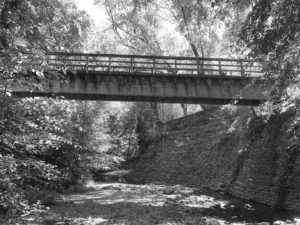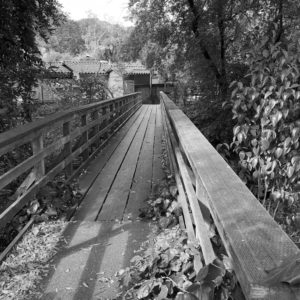
San Anselmo has its share of visual beauty – the surrounding hills, leafy tree-lined streets and the Seminary buildings, just to name a few. All of these are in plain sight. However, there are others not so noticeable that take a bit of searching to find. One of these is the footbridge which connects Karl and Sais Avenues. Originally built in 1916, it spans 86 feet across and over 20 feet above San Anselmo Creek at one of its widest points.
The bridge gives a view of the unspoiled creek not seen from the downtown footbridges. If you know where the bridge is, it’s easy to find. However, if you were just out walking, you would no doubt pass it by.
Karl Avenue, off Saunders Avenue, is a quiet street ending in a small cul-de-sac. At the end, there are a few homes, some trees and what appears to be a dirt road with a narrow sidewalk disappearing into the trees. There is no sign of anything beyond the trees. Following the sidewalk and just past the trees to your left, you are greeted with your first glimpse of the bridge. Not an imposing structure, but clearly one you may not have expected.
On the other side, Sais Avenue intersects with Calumet Avenue at the top of a small hill. Each road continues for a short distance and terminates in a dead end. Standing at the crossroads you may not notice the bridge as it is bathed in shadows from the trees. Following Sais Avenue down towards the end, the side of the bridge, its understructure and the creek come into view. The approach from this side is more dramatic as the creek bed drops almost straight down making it appear that you are moving towards a deep gorge.

The footbridge looking from Sais to Karl, 2018.
The bridge itself is a single span wooden structure only five feet wide with hand rails and footboards running lengthwise. It shows lots of wear, and at first glance you might be hesitant to cross, but you are drawn to venture out to experience the view up and down stream. From mid-span you can see for a fair distance, and the surrounding trees create a covered canopy making it feel as if you are in a cathedral. The serenity adds to this feeling as you listen to the movement of the water below and the birds in the trees above. Looking down when the creek is low, you can see the pier blocks that held the supports of the original structure. During the summer the creek is a small stream, but in winter it can become a raging torrent, and at flood stage, it’s best to stay off.
Over the years the bridge has been closed, condemned, repaired and replaced. The original 1916 bridge, described as “elegant,” was not paid for or built by the town, but was done so by the foresight and generosity of one of our early citizens, Laura Goldsmith Patterson.
Laura Goldsmith was born in San Francisco in 1860, the daughter of Master Mariner Joseph Goldsmith and his wife Elizabeth. She was the fifth or seven children. In 1899, Laura, “a handsome blond” bride, married sea captain James Buchanan Patterson. The Pattersons relocated to Seattle, Washington, where he was a port captain for the Pacific Coast Steamship Company. There were no children in the marriage, which may have led to Laura later caring about the young. The couple returned to San Francisco where Captain Patterson passed away in 1910 at the young age of 53. The San Francisco Chronicle said in his obituary that he was “one of the best and most widely known mariners sailing on the Pacific Coast.” Two years later in 1912, Laura Patterson built a home in the Carrigan Tract at 30 Sais Avenue. Her brother John N. Goldsmith and sisters Anna Goldsmith, Harriot Forrest and Clara Dowdell also purchased lots and built homes along the west side of Sais Avenue at about the same time.

Carrigan Tract, 1918. Sais Avenue runs across the center with homes along its west side. Laura Patterson’s home was the white one at the Nokomis intersection. Her brother and sisters owned the homes to the left along Sais.
From the very beginning of her arrival in San Anselmo, Patterson was a caring and giving person. During WWI, she modified and opened her home for returning convalescing soldiers. The San Anselmo Herald stated, “…we have that motherly woman in our big heart for all boys right in our midst in the person of Mrs. Laura Patterson.” Her name was consistently listed among donors to many causes, generally in the $50 to $100 range, a fair sum in the early part of the 20th century.
In 1916, Patterson noticed that the neighborhood children had a long walk, especially in the rain, to get to Lansdale School at Elm and San Anselmo Avenues. To cross the creek and avoid the Northwestern Pacific Railroad track and its electrified 3rd rail, they either had to go out to the County Road (today’s Sir Francis Drake) and up to Saunders to get to the Yolanda Station crossing or go down Nokomis Avenue towards the center of town. The same was true for the residents commuting on the train. What was needed was a footbridge across San Anselmo Creek, and the perfect point was a site just down Sais Avenue and directly across the creek from the Brennfleck nursery.
Three years earlier Bernard Brennfleck had sold four acres of his land creating Karl Avenue and the small subdivision of Karlsruhe Park. Now all that was needed was a 30-foot right of way on both sides of the creek and the bridge could become a reality. Laura Patterson spearheaded a fund drive to acquire the right of ways by starting off with $50 of her own money. Thirteen others, including her brother and two sisters, gave from $10 to $68 dollars, and enough was collected to purchase the land from Bernard Brennfleck. As a surprise, the Carrigan Tract Company donated a 30-foot right of way on the opposite bank.
Once the transfer of the right of ways to the town was completed, work on the bridge began. Architect Frank Farnkopf, who donated $30 to the purchase fund, also provided the plans free of charge. Patterson hired local contractors Hector Lanpher and Robert Wallace and personally paid the entire amount for the bridge construction “before the last nail was driven.” The Herald reported that the ornamental structure “will be very much appreciated by both old and young, for it means a good deal for everybody and above all for those who make the first start on the pathway of life to get training and knowledge.”
The bridge opened on September 29, 1916 to much fanfare, with the Herald reporting, “there were many people out looking the structure over and testing it Sunday, and the commuters find it mighty handy and a time saver in catching their trains and getting home. The women folks of the community have gotten their heads together and expect to make Mrs. Patterson a little present as a token of their thanks and appreciation.”
Laura Patterson passed away in February 1927 following an extensive seven-month stay at Ross General Hospital. The Herald reported, “she was known for her generosity and kindliness and leaves a wide circle of friends.” She also left current and future generations of San Anselmo a lovely reminder of the beauty of our own San Anselmo Creek.
Over the years the bridge was heavily used, and by 1942, it was in such bad condition that the town engineer recommended that it either be repaired or closed. A petition of 78 local property owners convinced Town Council to allocate the funds for repairs. This outpouring of support must have had an influence later when the bridge was again repaired in 1962 and when a total rebuild was undertaken in 1974.
The original need for the Karl-Sais Footbridge no longer exists. The Lansdale School and the commuter train are long gone. But now the bridge has a new reason for existing; providing the best crossing in all of San Anselmo.
Since 1916 the bridge has gone by several names; to old timers it was “The Green Bridge” due to its color, then as the town took ownership it has been referred to as the Karl-Sais Bridge. However, back in September 1916 when the bridge first opened, a neighbor of Laura Patterson, Otto Farnkopf (brother of Frank Farnkopf), had a sign made and attached it to the bridge on opening day. It simply stated, “The Patterson Bridge.” As a tribute to the generous person who first made the bridge possible, the Historical Commission will install signage on the bridge. It will read, “The Patterson Footbridge.”
By Rick Storms, San Anselmo Historical Commission
2019

